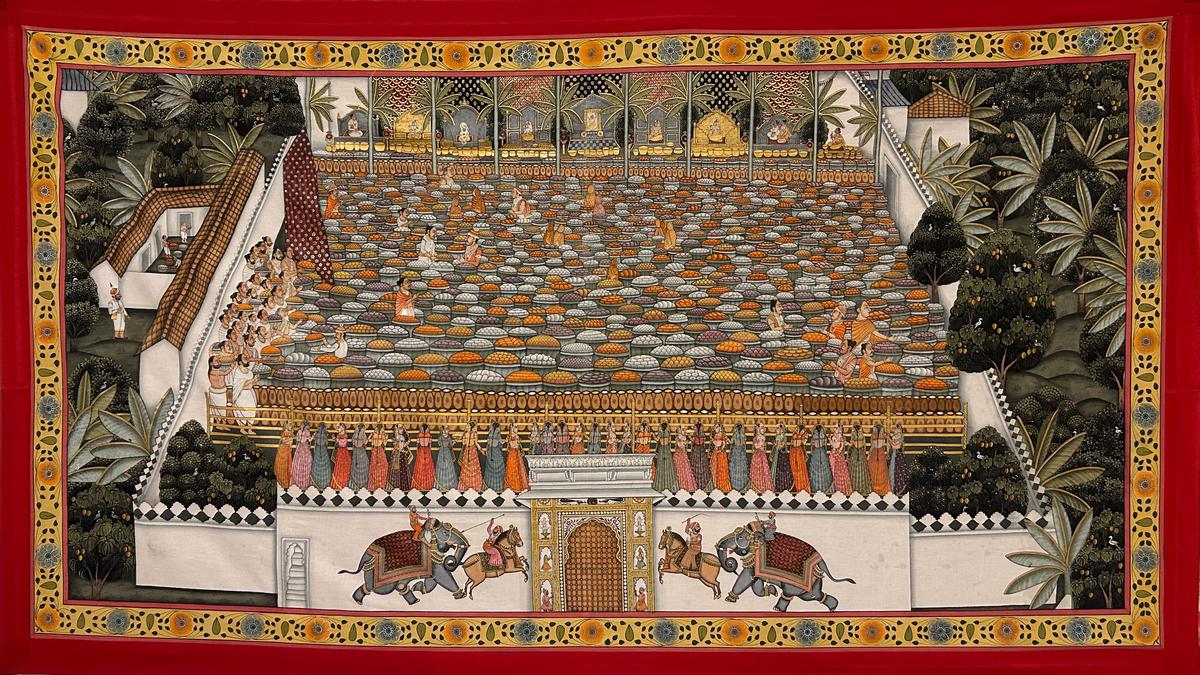About Pichwai Painting
- It is a traditional style of painting that originated in the state of Rajasthan in India.
- The history of this art form can be traced back to the 17th century.
- It is believed to have originated in the town of Nathdwara in Rajasthan.
- Theme: It mainly features the various stages of Lord Krishna’s life.
- Material used: The artists use stone pigments, especially for gold and silver tones. The brighter orange, red, chrome yellow and kesari colours come from vegetable dyes
- Other schools of Pichwai — Nathdwara, Kishangarh and Bundi in Rajasthan and Deccan school
- They are often used to decorate the backdrops of Hindu temples, where they serve as a visual representation of the stories associated with Lord Krishna.
- These paintings have distinct features of a heavier body and large elongated eyes, with a broad nose of Shrinathji, similar to the features of the idol at the temple.
- The paintings are often filled with details, such as flowers, animals, and geometric patterns, which are arranged in a symmetrical and balanced composition.
- Some of the famous Pishwai Paintings are:
- Shrinathji in Black & Gold
- Ras Leela – Krishna with Radha
- Giriraja Pichwai – depicting Lord Krishna carrying Govardhana mountain on his little finger
Q1) What is Kishangarh painting?
It is a distinctive style of Indian miniature painting that emerged in the princely state of Kishangarh, which is located in the modern-day Indian state of Rajasthan. This style of painting is known for its unique and romanticized portrayal of Radha and Lord Krishna, as well as for its elongated and ethereal depictions of human figures.
Source: Chennai hosts an art exhibit showcasing Pichwai, some dating back 350 years
Last updated on June, 2025
→ UPSC Notification 2025 was released on 22nd January 2025.
→ UPSC Prelims Result 2025 is out now for the CSE held on 25 May 2025.
→ UPSC Prelims Question Paper 2025 and Unofficial Prelims Answer Key 2025 are available now.
→ UPSC Calendar 2026 is released on 15th May, 2025.
→ The UPSC Vacancy 2025 were released 1129, out of which 979 were for UPSC CSE and remaining 150 are for UPSC IFoS.
→ UPSC Mains 2025 will be conducted on 22nd August 2025.
→ UPSC Prelims 2026 will be conducted on 24th May, 2026 & UPSC Mains 2026 will be conducted on 21st August 2026.
→ The UPSC Selection Process is of 3 stages-Prelims, Mains and Interview.
→ UPSC Result 2024 is released with latest UPSC Marksheet 2024. Check Now!
→ UPSC Toppers List 2024 is released now. Shakti Dubey is UPSC AIR 1 2024 Topper.
→ Also check Best IAS Coaching in Delhi
























